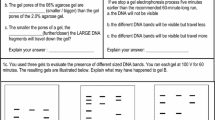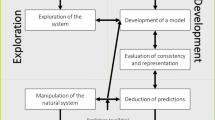Abstract
This paper presents and discusses empirical results from a survey about the research practice of Danish chemistry students, with a main focus on the question of anomalous data. It seeks to investigate how such data is handled by students, with special attention to so-called ‘questionable research practices’ (QRPs) where anomalous data are simply deleted or discarded. This question of QRPs is of particular importance as the educational practices students experience may influence how they act in their future professional careers, for instance in research. The ethical evaluation of QRPs however is not univocal. In parts of the literature QRPs are seen as unquestionably bad, while in other parts of the literature certain QRPs are seen as a necessary aspect of scientific practice. Results from the survey of Danish chemistry students shows that many students engage in certain types of questionable practices, and that a large minority of the students have been actively encouraged by their teachers to engage in such practices. The paper discusses to what extent and under what circumstances such instructional practices can be defended and suggests how the instructional practice connected to the handling of anomalous data can be improved.
Similar content being viewed by others
Notes
For instance, in the ABET criteria concerning Student Outcomes two of the eleven learning outcomes are: “(b) an ability to design and conduct experiments, as well as to analyze and interpret data” and “(f) an understanding of professional and ethical responsibility” (ABET 2017, p. 3).
In the paper, Mike Smith and Lawrence Scharmann deliberately seek to replace the sharp demarcation between science and non-science with a qualitative continuum, where a given field can be seen as ‘more’ or ‘less’ scientific depending on certain charateristics.
References
Abd-El-Khalick, F. (2013). Teaching with and about nature of science, and science teacher knowledge domains. Science & Education,22, 2087–2107.
ABET (2017). Criteria for accrediting engineering programs—effective for reviews during the 2017–2018 accreditation cycle. Engineering Accreditation Commission. http://www.abet.org/wp-content/uploads/2016/12/E001-17-18-EAC-Criteria-10-29-16-1.pdf. Retrieved from 21 March 2018.
Belter, R. W., & du Pré, A. (2009). A strategy to reduce plagiarism in an undergraduate course. Teaching of Psychology,36(4), 257–261.
Chinn, C. A., & Brewer, W. F. (1993). The role of anomalous data in knowledge acquisition: A theoretical framework and implications for science instruction. Review of Educational Research,63(1), 1–49.
Coady, C. A. J. (1992). Testimony: A Philosophical Study. Oxford: Clarendon Press.
Davis, S., Drinan, P. F., & Gallant, T. B. (2009). Cheating in School, What we Know and What we Can Do. Chichester: Wiley-Blackwell.
De Vries, R., Anderson, M., & Martinson, B. C. (2006). Normal misbehavior: Scientists talk about the ethics of research. Journal of Empirical Research on Human Research Ethics: An International Journal,1(1), 43–50.
Dobzhansky, T. (1967). Review: Looking back at mendel’s discovery. Science, New Series,156(3782), 1588–1589.
Fanelli, D. (2009). How many scientists fabricate and falsify research? A systematic review and meta-analysis of survey data. PLoS ONE,4(5), e5738. https://doi.org/10.1371/journal.pone.0005738.
Farley, J., & Geison, G. (1974). Science, politics and spontaneous generation in nineteenth-century France: The Pasteur–Pouchet debate. Bulletin of the History of Medicine,48(2), 161–198.
Fine, A. (1998). The viewpoint of no one in particular. In Proceedings and Addresses of the American Philosophical Association, 72(2), pp. 7–20.
Harding, T. S., Carpenter, D. D., Finelli, C. J., & Passow, H. J. (2004). Does academic dishonesty relate to unethical behavior in professional practice? An exploratory study. Science and Engineering Ethics,10(2), 311–324.
Hardwig, J. (1985). Epistemic dependence. Journal of Philosophy,82(7), 335–349.
Henslee, A., Murray, M., Olbricht, S., Ludlow, L., Hays, G., & Nelson, R. (2017). Assessing freshman engineering students’ understanding of ethical behavior. Science and Engineering Ethics,23(1), 287–304.
Hofstein, A., & Lunetta, V. N. (2004). The laboratory in science education: Foundations for the twenty-first century. Science Education,88(1), 28–54.
Holton, G. (1978). Subelectrons, presuppositions, and the Millikan–Ehrenhaft Dispute. Historical Studies in the Physical Sciences,9, 161–224.
Hughes, J. M. C., & McCabe, D. L. (2006). Academic misconduct within higher education in Canada. Canadian Journal of Higher Education,36(2), 1–21.
John, L., Loewenstein, G., & Prelec, D. (2012). Measuring the prevalence of questionable research practices with incentives for truth telling. Psychological Science,23(5), 524–532.
Kipnis, N. (2011). Errors in science and their treatment in teaching science. Science & Education,20(7–8), 655–685.
Kuhn, T. S. (1959). The essential tension: Tradition and innovation in scientific research. In C. W. Taylor & F. Barron (Eds.), Scientific Creativity: Its Recognition and Development (pp. 341–354). New York: John Wiley & Sons Inc.
Martinson, B. C., Anderson, M. S., & De Vries, R. (2005). Scientists behaving badly. Nature,435(7043), 737–738.
McCabe, D. L. (1997). Classroom cheating among natural science and engineering majors. Science and Engineering Ethics,3(4), 433–445.
McCabe, D. L. (2005). Cheating among college and university students: A North American perspective. International Journal for Educational Integrity, 1(1). https://www.ojs.unisa.edu.au/index.php/IJEI/article/view/14. Retrieved from 21 March 2018. http://dx.doi.org/10.21913/IJEI.v1i1.14.
McCabe, D. L., Trevino, L., & Butterfield, K. (2001). Cheating in academic institutions: A decade of research. Ethics and Behavior,11(3), 219–232.
Merriam-Webster (2017). Online dictionary (https://www.merriam-webster.com). The online dictionary was accessed October 6 2017 with the search key “questionable”.
Michaels, D. (2007). Doubt is their product, how industry’s assault on science threatens your health. Oxford: Oxford University Press.
Miñano, R., Uruburu, Á., Moreno-Romero, A., & Pérez-López, D. (2017). Strategies for teaching professional ethics to IT engineering degree students and evaluating the result. Science and Engineering Ethics,23(1), 263–286.
Mumford, M. D., Connelly, S., Brown, R. P., Murphy, S. T., Hill, J. H., Antes, A. L., et al. (2008). A sensemaking approach to ethics training for scientists: Preliminary evidence of training effectiveness. Ethics and Behavior,18(4), 315–339.
Polanyi, M. (1967). The Tacit Dimension. London: Routledge & Kegan Paul Ltd.
Ravetz, J. R. (1971). Scientific Knowledge and its Social Problems. Oxford: Clarendon Press.
Reid, N., & Shah, I. (2007). The role of laboratory work in university chemistry. Chemistry Education Research and Practice,8(2), 172–185.
Shapin, S. (1995). Trust, honesty and the authority of science. In R. E. Bulger, E. Meyer Bobby, & H. V. Fineberg (Eds.), Society’s Choices: Social and Ethical Decision Making in Biomedicine (pp. 388–408). Washington: National Academies Press.
Smith, M. U. (2013). The role of authority in science and religion with implications for science teaching and learning. Science & Education,22(3), 605–634.
Smith, M. U., & Scharmann, L. C. (1999). Defining versus describing the nature of science: A pragmatic analysis for classroom teachers and science educators. Science Education,83(4), 493–509.
Steneck, N. (2006). Fostering integrity in research: Definitions, current knowledge, and future directions. Science and Engineering Ethics,12(1), 53–74.
Strauss, A. L. (1987). Qualitative Analysis for Social Scientists. New York: Cambridge University Press.
Swazey, J. P., Anderson, M. S., & Lewis, K. S. (1993). Ethical problems in academic research. American Scientist,81(6), 542–553.
VanDeGrift, T., Dillon, H., & Camp, L. (2017). Changing the engineering student culture with respect to academic integrity and ethics. Science and Engineering Ethics,23(4), 1159–1182.
Washburn, J. (2005). University Inc., The Corporate Corruption of American Higher Education. New York: Basic Books.
Wu, C.-F. (2003). A study of the adjustment of ethical recogntion and ethical decision-making of managers-to-be across the Taiwan Strait before and after receiving a business ethics education. Journal of Business Ethics,45(4), 291–307.
Zigmond, M. J., & Fischer, B. A. (2002). Beyond fabrication and plagiarism: The little murders of everyday science. Science and Engineering Ethics,8(2), 229–234.
Ziman, J. (2000). Real Science: What it is and what it means. Cambridge: Cambridge University Press.
Author information
Authors and Affiliations
Corresponding author
Additional information
Publisher's Note
Springer Nature remains neutral with regard to jurisdictional claims in published maps and institutional affiliations.
Rights and permissions
About this article
Cite this article
Johansen, M.W., Christiansen, F.V. Handling Anomalous Data in the Lab: Students’ Perspectives on Deleting and Discarding. Sci Eng Ethics 26, 1107–1128 (2020). https://doi.org/10.1007/s11948-020-00206-4
Received:
Accepted:
Published:
Issue Date:
DOI: https://doi.org/10.1007/s11948-020-00206-4




